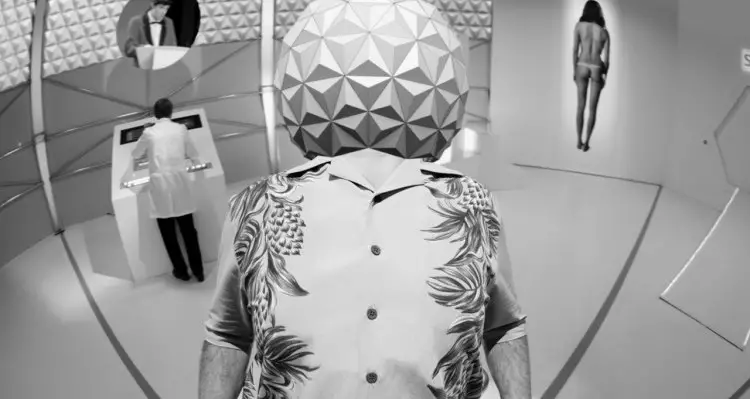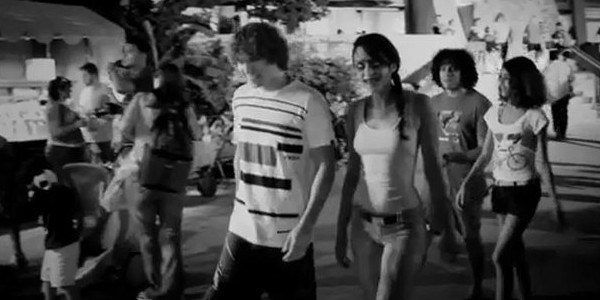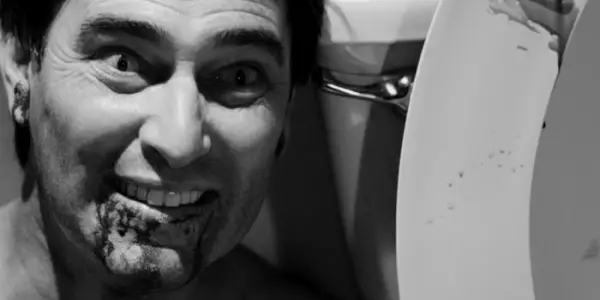Unfocused, Unstable Horror: ESCAPE FROM TOMORROW

Derrek is a film enthusiast from Buffalo, NY. When he's…
Escape From Tomorrow is a nightmare in black and white. From the opening moments to the final scene, the story unfolds in the most mind-bending ways. I grew up with very little black and white film. I had seen clips from The Tramp and a couple Abbott and Costello movies but it wasn’t an integral part of my childhood movie interest. I assumed it was a technical limitation of the time, that everything after a certain date would be in glorious color. The first modern film I watched in black and white was Clerks. It was somewhat jarring at first viewing. Why would anyone shoot in black and white when color was so much more interesting? (How little I knew about the cost of making an independent film.) I quickly learned that you can’t judge a film by its color palette.

Madness in Monochrome
Randy Moore‘s writing/directorial debut proves just that. The choice to use black and white came from a unique pressure during filming. The movie was shot guerrilla style at Disney World and Disney Land. Using cameras that would be similar to high-end consumer cameras other park patrons would have, they shot the movie in monochrome mode to help offset the issues with controlling their light sources. It also gave the film an ominous mood. In his interview with Filmmaker Magazine, Moore stated:
I always knew from the get-go that I wanted this film to have an eerie, dream-like quality, and, above all else, not feel like a home movie. Plus, I’d never seen this “world” in black and white before.
The lack of color makes the horror scenes far more surreal. When the story’s protagonist starts to hallucinate, the gray-scale lends itself to a sinister feeling, like the darkness is creeping in. Park rides that would be colorful and whimsical feel claustrophobic and full of despair.
The Problem With No Permission
The independent production of the film and lack of consent from Disney created other unique issues. The film had to be laid out beginning to end, both parks had to be mapped out, every scene timed and blocked accordingly. Where in the park could they shoot multiple takes without drawing attention? What time of day did they need to be at each “set?” Moore summarized some of the preparation for the film:
The schedule was extensive and planned carefully weeks ahead of time to coincide with the direct location of the sun during each shot… We must have walked through the entire movie at least eight or nine times during multiple scouting trips before we ever rolled camera.

I can’t imagine what it took to organize a film like this. Many of the shots were taken while in line for and on some of the rides. Doing one take without suspicion could be difficult, but the fact that they were able to do multiple takes and film the vast majority of scenes on site is impressive. Some interior shots were filmed on sound stages and in a few scenes the green screen is very apparent. But under the circumstances, it really didn’t take anything away from the movie.
A Plot Like Play-Doh
I originally wrote the above heading because I liked the consonance, but it’s an apt analogy. The film is fluid in its driving forces. What starts out as stress induced hallucinations on the last day of the family trip quickly devolves into a full mental break. It’s like listing a Who’s Who of horror tropes. Lying to the wife and kids, the impure thoughts of a married man, acid-like forays into simple children’s rides, influenza, conspiracies, magic and evil, kidnapping and creepy children, constantly being molded by the director to keep you guessing what’s next. Because of this bohemian construction, the film is never boring but it can go off the rails a bit. I avoided writing a review of this film because I felt any attempt to describe it beyond general terms would do it injustice.

Due to the unstable nature of the plot, I can’t really tell you the theme of the movie, or even explain what it’s about. It felt like a confirmation of the urban myths surrounding the Disney parks; a conspiracy theorists manifesto come true. As horror plays out, the movie makes you anxious and itchy. The changes in tone keep you from relaxing and blindly following the story. However, the entire time you’re on this ridiculous journey, you want to find the answers, discover the truth hidden behind every door. It seems random and yet only draws you in more, jaw agape, until the very end.
This film is something you have to see to believe.
What do you think of unfocused horror? Do you need a targeted story line – the reason behind the evil – or are you willing to follow the rabbit hole deeper? Are there any other films that do this successfully, throwing you into the deep end and leaving you to fend for yourself? Discuss with us in the comments.
If you enjoyed reading this article, don’t forget to share it on your social networks!
Does content like this matter to you?
Become a Member and support film journalism. Unlock access to all of Film Inquiry`s great articles. Join a community of like-minded readers who are passionate about cinema - get access to our private members Network, give back to independent filmmakers, and more.
Derrek is a film enthusiast from Buffalo, NY. When he's not busy fighting crime or rescuing kittens, he works as a designer for an automotive manufacturer. His favorite way to unwind after a long week is with a new movie or an old favorite. From Alice in Wonderland to The Avengers, from Zorro to Zoolander, let's talk film.













